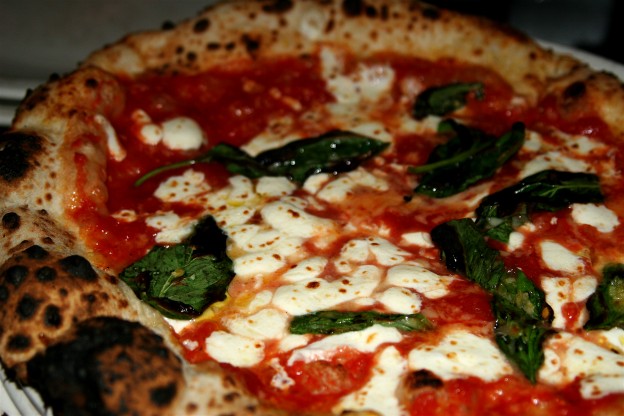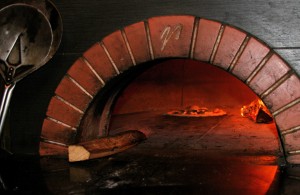
Pizza Magherita at Posto (all photos: Elizabeth Hathaway/PRK)
Unless you live in Davis Square, pizza at your neighborhood pizza joint does NOT look like this.
Last October is when I first heard of Pizzeria Posto, site of the old Carbury’s. I’ve eaten there three times since. Still, my first encounter with Posto’s artisanal pizzas sticks with me. “I haven’t seen a pizza look like this in ages,” I thought. Since the week I lived and ate in Naples is what I meant. Such an automatic, visceral connection with Naples, I am guessing, would make Posto chef/owner Joe Cassinelli proud.
Though it opened as recently as 2010, Posto is the only restaurant in New England certified as a maker of vera pizza napoletana, true Neapolitan-style pizza. The certification came last year, awarded in 2011 by the California-based organization of the same name: Associazione Verace Pizza Napoletana (VPN).
Cassinelli, a native of Milford, had already been making well-crafted pizzas when he arrived at VPN’s American headquarters in Marina Del Rey, CA, for the three-day training course. He also had read a lot, taking it upon himself to learn what he could about making Neapolitan-style pizza before he trained with the experts. Cassinelli was confident.
But VPN said ‘no, not yet,’ and Cassinelli felt the same. He waited almost a year after the formal training to approach VPN again. He felt he knew enough, had the right equipment — more on that in a minute — and had imparted enough knowledge to his staff to try for certification. (Indeed, the VPN qualification applies to Posto, not to Cassinelli, personally. His main pizza maker, Juan Perez, is therefore extremely important to the Posto team.)
“A lot of people think this is [a joke],” Cassinelli offered. “You send some guys a check and you’re in.” On the contrary, certification is competitive and must be renewed each year. This means random, unannounced visits by VPN officials who re-evaluate the oven, the mixing of the dough, the quality of the home-made mozzarella and the imported tomatoes used at Posto (San Marzano only).
It was Cassinelli’s idea to go after the certification. But it was emphatically not a marketing ploy. “It’s important to know where you come from,” said Cassinelli. “You’ve gotta’ keep your heritage alive. Otherwise, where are you?”
Here’s where Cassinelli is. With this certification, Posto puts out a soft, elastic, small-plate pizza that’s super fresh. Neapolitan-style means a 90-second bake (yes, seconds) of each hand-made pizza in a coal or wood-fired oven. No one pizza is the same and each needs to be “perfect.” There’s no room for error, Cassinelli implores, because the cooking is so rapid.

The "V" emblazoned on Posto's oven is for Valoriani
This brings us to the topic of heat. Clearly, if a raw pizza topped with ingredients is to cook appropriately in a little over a minute, you’re going to need one hot oven. At Posto, the Italian-made Valoriani oven is dome-shaped and made of brick. Only kiln-dried wood is used. When I arrived at Posto at 4 PM on a weekday for this interview, the resting heat of the oven’s interior was 440 degrees Fahrenheit. From the day before. Once fired anew for the evening’s dinner rush, the temperature in the dome will reach 1,000 degrees. The 8-10″ thick layer of brick in Posto’s oven retains radiant heat extremely well, Cassinelli explains, which means it remains continually hot and reheats quickly. In a word, this is a most heat-efficient oven.
But, consider. In an oven that hot, for a pizza whose signature trait is a rapid cook, the quality and texture of the ingredients count a lot. Cassinelli imports the flour (protein-rich “00 farina”) at twice the cost of other flours on account of its quality and the manner in which it reacts with water. A relatively wet dough is critical to this pizza style to prevent the high heat of the oven from drying out the dough.
Posto’s house-made mozzarella — 50 lbs., hand-formed daily — is the opposite. It must be on the drier side so that, once placed in an 800-degree oven, the cheese melts immediately without becoming mush. Such a no-no would ruin the texture of the tomatoes on which it sits — tomatoes that should thicken, ideally. Cassinelli’s comment about “the dance” begins to make sense.
 How the dough is mixed is also important. At Posto, pizza dough is prepared daily with the aid of another imported item Cassinelli waited five long months to receive (you can hardly call it a “gadget” — it’s huge). Meet the fork-mixer, a sleek, steely beast whose bowl rotates at the same time as the massive paws, or tines, move in synch to work the dough. Cassinelli, mellow as ever, remarked that the texture of the dough and its “strength” changed overnight once the fork mixer arrived. The “mouth feel” of the dough improved.
How the dough is mixed is also important. At Posto, pizza dough is prepared daily with the aid of another imported item Cassinelli waited five long months to receive (you can hardly call it a “gadget” — it’s huge). Meet the fork-mixer, a sleek, steely beast whose bowl rotates at the same time as the massive paws, or tines, move in synch to work the dough. Cassinelli, mellow as ever, remarked that the texture of the dough and its “strength” changed overnight once the fork mixer arrived. The “mouth feel” of the dough improved.
Still, first-class industrial mixer aside, Posto “babies” its pizza dough. Cassinelli explains that very little yeast is used; the dough is therefore allowed to ferment for a long time and requires a good bit of time to rise. Flavor intensifies as a result, and the dough poses no danger of over-proofing.

These qualities become all-important in a dough that supports hand-crafted mozzarella and the highest-quality Italian tomato on the market, San Marzano. These two ingredients, in combination or standing on their own, make up the two “DOC” pizzas customers will always find on the menu at Posto: the Pizza Margherita DOC (San Marzano, basil, homemade fior di latte, parmesan) and the Pizza Marinara DOC (San Marzano, garlic, oregano, parmesan).
As Cassinelli explains it, these two pizzas are the “foundation” of true Neapolitan pizza. “Even if the world changes,” the Margherita and Marinara pizzas — made with these specific ingredients in this particular way — will not. We’re back again to Cassinelli’s philosophy about ‘knowing where you come from.’
But Posto’s pizza menu, and all its antipasti and hand-made pasta offerings, is far more broad than tomato, cheese and dough. Cassinelli is a firm believer in sourcing local: it’s good business, it’s neighborly and it’s Italian. “Italy is all about local and fresh,” Cassinelli observes. “They ARE slow food.”
Posto therefore looks to farmers in Vermont, Maine, Pennsylvania, Massachusetts and New Hampshire for its organic, hormone- and antibiotic-free meats. Chicken comes from Giannone Poultry in Canada. Massachusetts-grown apples, corn, heirloom tomatoes and string beans are “the best” in Cassinelli’s estimation. Posto customers love this local angle, Cassinelli says.
Though it’s been “challenging” to get people to understand the unique rules and ingredients that go into making vera pizza napoletana, Cassinelli says Posto is building an “extremely loyal clientele,” and they return with friends in tow. This means new faces, more teaching “one-on-one.” The restaurant has hit a rhythm, and the busy dining room shows it.
Cassinelli rues the day he named his newest venture “Pizzeria” Posto. Pizzeria connotes the Americanized, uniform, long-baked pies you get when you slide into a Formica booth to eat. Posto’s pizza style, Cassinelli is taking pains to show, is different.

Pingback: AndyTalk: Why You Should Make Pizza From Scratch » MakeTube
Pingback: The Reeducation Of A Tri-State Pizza Purist | Public Radio Kitchen